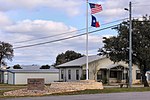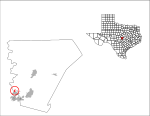Texas Chainsaw House

The Texas Chainsaw House is located in Kingsland, Texas, on the grounds of The Antlers Hotel. This 1900s Victorian house was featured prominently in Tobe Hooper's horror film The Texas Chain Saw Massacre as the home of Leatherface and his cannibalistic family, before it was moved to this location from Williamson County in 1998. The then-dilapidated farm house originally sat on Quick Hill Road during the July–August 1973 filming of the movie. The original site is where La Frontera is now located, in Round Rock. Location of The Texas Chain Saw Massacre farmhouse at Quick Hill – 30.480277°N 97.692522°W / 30.480277; -97.692522 (Site of 'The Texas Chain Saw Massacre' farmhouse at Quick Hill)In 1998, the house was cut into six pieces in order to be moved, then reassembled and restored to its original condition by master carpenter Anthony Mayfield on behalf of an investor couple in Austin, Texas. The house was a "pattern book" house, ordered from a catalog and assembled on site from a package of materials brought by wagon from a local lumber company. Research indicates it was likely built between 1908 and 1910.
Excerpt from the Wikipedia article Texas Chainsaw House (License: CC BY-SA 3.0, Authors, Images).Texas Chainsaw House
King Court,
Geographical coordinates (GPS) Address Website Nearby Places Show on map
Geographical coordinates (GPS)
| Latitude | Longitude |
|---|---|
| N 30.660222222222 ° | E -98.437138888889 ° |
Address
Grand Central Cafe & Club Car Lounge
King Court 1010
78639
Texas, United States
Open on Google Maps










